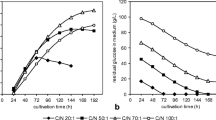Summary
The purpose of these studies was to investigate wether the primary step in the reaction chain of the light-dependent carotenoid synthesis in heterotrophic organisms, the photochemical reaction of the photoreceptor, requires oxygen. Submerged cultures of Fusarium aquaeductuum and Neurospora crassa were used.
Biosynthesis of carotenoids following a photoinduction occurred only under aerobic conditions. When the mycelia were illuminated in the absence of oxygen and subsequently transferred to aerobic conditions in the dark, they produced carotenoids; however, the amount of pigments produced was lower in comparison to that synthesized after photoinduction in O2 atmosphere. Under anaerobic conditions light saturation of photoinduction occurred at a dosage of approximately 5.103 Lux. min (white light) in both organisms; this dosage was independent of light intensity and time of illumination. The photoeffect followed the reciprocity law even in the absence of oxygen. The amount of pigments synthesized following a saturating photoinduction under anaerobic conditions was 10% in Fusarium and 75% in Neurospora of that after photoinduction under aerobic conditions. When mycelia were illuminated in N2 atmosphere with saturating dosages, subsequently supplied with oxygen in the dark and then illuminated a second time with or without oxygen, an additional photoinduction took place. This result indicates that the photoreceptor can be reactivated by oxygen. This reactivation is completed in approximately 10 min; it is independent of temperature and does not occur in the absence of oxygen.
From these results it is concluded that oxygen does not directly participate in the primary photochemical event but functions as an electron acceptor to keep the photoreceptor (possibly a flavin) in the proper oxidation state.
Zusammenfassung
Ziel der vorliegenden Untersuchungen was es, zu prüfen, ob der erste Schritt in der Reaktionskette der lichtabhängigen Carotinoidsynthese von heterotrophen Organismen, die photochemische Reaktion des Lichtacceptors, obligat sauerstoffbedürftig ist. Durch Belichtung unter anaeroben Bedingungen wird bei Fusarium aquaeductuum und Neurospora crassa Carotinoidsynthese induziert; die Farbstoffmenge im Mycel ist allerdings geringer als nach Belichtung unter aeroben Bedingungen. Bei beiden Pilzen wird in N2-Atmosphäre Lichtsättigung bei etwa 5·103 Lux·min erreicht und zwar unabhängig von der eingestrahlten Lichtintensität und Belichtungszeit; die höchste induzierbare Carotinoidmenge beträgt bei Fusarium 10%, bei Neurospora 75% von derjenigen, die nach Belichtung unter O2 maximal gebildet wird. Führt man dem Mycel im Anschluß an eine sättigende Belichtung unter anaeroben Bedingungen im Dunkeln Sauerstoff zu, so wird durch eine darauf folgende 2. Belichtung eine zusätzliche Carotinoidsynthese induziert; der Photoreceptor wird also offenbar durch O2 wieder reaktiviert. Diese Reaktivierung wird als Reoxidation des Photoreceptors (wahrscheinlich ein Flavin) interpretiert; sie ist innerhalb von 10 min abgeschlossen und temperaturunabhängig. Aus den Ergebnissen wird geschlossen, daß der Sauerstoff an der photochemischen Reaktion des Photoreceptors nicht direkt beteiligt ist, sondern nur als Elektronenacceptor für die Reoxidation des Photoreceptors dient.
Similar content being viewed by others
Literatur
Batra, P. P., and H. C. Rilling: On the mechanism of photoinduced carotenoid synthesis: Aspects of the photoinductive reaction. Arch. Biochem. 107, 485–492 (1964).
Bloch, K., P. Baronowsky, H. Goldfine, W. J. Lennarz, R. Light, A. T. Norris, and G. Scheuerbrandt: Biosynthesis and metabolism of unsaturated fatty acids. Fed. Proc. 20, 921–927 (1961).
Brauner, L., u. M. Brauner: Untersuchungen über die Photolyse des Heteroauxins II. Z. Bot., 42, 83–124 (1954).
Claes, H.: Biosynthese von Carotinoiden bei Chlorella. III. Untersuchungen über die lichtabhängige Synthese von α-und β-Carotin und Xanthophyllen bei der Chlorella-Mutante 5/520. Z. Naturforsch. 12b, 401–407 (1957).
Galston, A. W.: Riboflavin-sensitized photooxidation of indoleacetic acid and related compounds. Proc. nat. Acad. Sci. (Wash.) 35, 10–17 (1949).
Grob, E. C.: The biosynthesis of carotenoids by microorganisms. Ciba Foundation Symp. on Biosynthesis of Terpenes and Sterols 1959, p. 267–276.
Haxo, F.: Studies on the carotenoid pigments of Neurospora. 1. Composition of the pigment. Arch. Biochem. 20, 400–421 (1949).
Mathews, M. M.: Studies on the localization, function and formation of the carotenoid pigments of a strain of Mycobacterium marinum. Photochem. Photobiol. 2, 1–8 (1963).
Oster, G., J. S. Bellin, and B. Holmström: Photochemistry of riboflavin. Experientia (Basel) 18, 249–253 (1962).
Pfennig, N.: Photosynthetic bacteria, in: Ann. Rev. Microbiol. 21, 285–324 (1967).
Porter, J. W., and D. G. Anderson: The biosynthesis of carotenes. Arch. Biochem. 97, 520–532 (1962).
Rau, W.: Über den Einfluß der Temperatur auf die lichtabhängige Carotinoidsynthese von Fusarium aquaeductuum. Planta (Berl.) 59, 123–137 (1962).
—: Untersuchungen über die lichtabhängige Carotinoidsynthese. I. Das Wirkungsspektrum von Fusarium aquaeductuum. Planta (Berl.) 72, 14–28 (1967a).
—: Untersuchungen über die lichtabhängige Carotinoidsynthese. II. Ersatz der Lichtinduktion durch Mercuribenzoat. Planta (Berl.) 74, 263–277 (1967b).
— I. Lindemann u. A. Rau-Hund: Untersuchungen über die lichtabhängige Carotinoidsynthese. III. Die Farbstoffbildung von Neurospora crassa in Submerskultur. Planta (Berl.) 80, 309–316 (1968).
—, u. C. Zehender: Die Carotimoide von Fusarium aquaeductuum Lagh. Arch. Mikrobiol. 32, 423–428 (1959).
Rilling, H. C.: Photoinduction of carotenoid synthesis of a Mycobacterium sp. Biochim. biophys. Acta (Amst.) 60, 548–556 (1962).
—: Anaerobic carotenoid synthesis by an aerobic microorganism. Biochim. biophys. Acta (Amst.) 65, 156–158 (1962b).
—: On the mechanism of photoinduction of carotenoid synthesis. Biochim. biophys. Acta (Amst.) 79, 464–475 (1964).
Zalokar, M.: Studies on biosynthesis of carotenoids in Neurospora crassa. Arch. Biochem. 50, 71–80 (1954).
—: Biosynthesis of carotenoids in Neurospora. Action spectrum of photoactivation. Arch. Biochem. 56, 318–325 (1955).
Zenk, M. H.: Untersuchungen zum Phototropismus der Avena-Koleoptile. I. Photooxydationen in vivo. Z. Pflanzenphysiol. 56, 57–69 (1967a).
—: Untersuchungen zum Phototropismus der Avena-Koleoptile: II. Pigmente. Z. Pflanzenphysiol. 56, 122–140 (1967b).
Author information
Authors and Affiliations
Rights and permissions
About this article
Cite this article
Rau, W. Untersuchungen über die lichtabhängige Carotinoidsynthese. Planta 84, 30–42 (1968). https://doi.org/10.1007/BF00384819
Received:
Issue Date:
DOI: https://doi.org/10.1007/BF00384819




